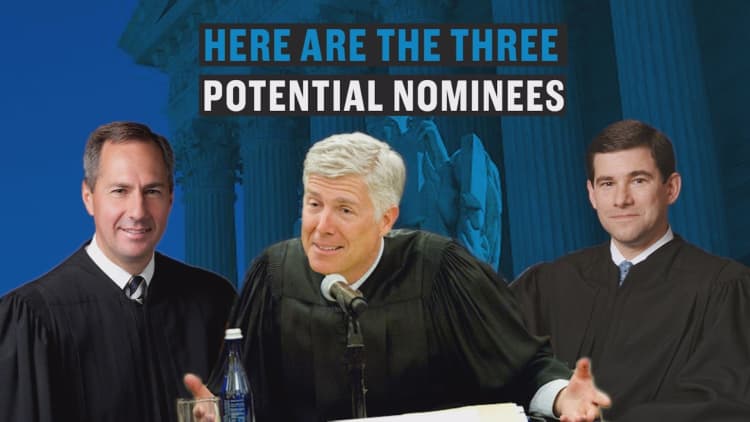
President Donald Trump is expected to name his Supreme Court choice on Tuesday night. Here's everything you need to know about what the confirmation process might be like.
Why is Trump picking a justice now?
There has been a vacancy on the nine-member Supreme Court since the death of Justice Antonin Scalia on Feb. 13, 2016. The next month, President Barack Obama nominated U.S. Appeals Judge Merrick Garland for the job. Republicans blocked a vote and even hearings on the nomination, meaning the vacancy became Obama's successor's to fill.
How were Republicans able to block a nomination?
Before and after the 2016 election, Republicans held a majority in the Senate, giving Republican Majority Leader Mitch McConnell of Kentucky broad control over confirmation hearings and votes. McConnell argued that it was unfair for a president who was just months from being replaced to choose a court pick in the heat of an election season.
In making that argument, McConnell referenced the so-called Biden Rule, an idea that dates to 1992 — and, yes, that Joe Biden. Back then, Biden warned against hypothetical Supreme Court confirmation hearings during a contentious presidential election, saying it would be "not fair to the president, to the nominee or to the Senate itself."
What did Joe Biden have to say about that?
As you might expect, he was not happy. You can read more about that here.
More from NBC News:
Civil liberties groups to Donald Trump: 'See you in court'
Draft order eyes return to overseas CIA prisons
Trump signs orders aimed at cracking down on illegal immigration
So Trump will announce his pick this week. What next?
The basics are laid out in the Constitution's Appointments Clause, which states: "He [the President] shall have the Power, by and with the Advice and Consent of the Senate, to make Treaties, provided two-thirds of the Senators present concur; and he shall nominate, and by and with the Advice and Consent of the Senate, shall appoint Ambassadors, other public Ministers and Consuls, Judges of the supreme Court, and all other Officers of the United States, whose Appointments are not herein otherwise provided for, and which shall be established by Law."
What "advise and consent" means in the modern era is that the Senate Judiciary Committee holds televised hearings with the nominee and then votes on the nomination; if the committee votes to move forward with the pick, the full Senate votes on confirmation.
How long will that take?
Since 1975, the 14 Supreme Court nominees who faced a full Senate confirmation vote waited an average of about 67 days from their nominations to votes, according to the Congressional Research Service. The shortest wait was for Justice John Paul Stevens, whose nomination was pending for only 19 days. Robert Bork, whose nomination was ultimately defeated in 1987, waited 108 days.
How many votes does the nominee need?
To be confirmed, the nominee needs a simple majority in the Senate. But Supreme Court nominees — at least as of now — can be still filibustered, which means that 60 senators must vote to keep the nomination alive. At least one Democrat, Sen. Jeff Merkley of Oregon, says he'll try to block Trump's pick. If 41 senators decide to fight the nomination, it could get stuck and fail. But it also depends on whether the rules stay the same or get changed.
Didn't the Senate do something like that already?
Yes, but it didn't apply to Supreme Court justices. In 2013, Senate Democrats used an obscure set of parliamentary procedures to change the rules so most presidential appointments could no longer be filibustered.
For an institution that's all about rules and precedent, it was a very dramatic move, so it got a dramatic name: the "nuclear option." At the time, Democrats argued that Republican obstructionism had gotten so bad that they weren't able to push through the judges, Cabinet secretaries and agency heads whom the government needs in place to run the government. But the big exception was that it excluded Supreme Court justices, keeping the filibuster in place for them.
Can Republicans remove the possibility of a filibuster?
They definitely could, although it's not clear that Republicans want to be forced to do that. Trump said last week that he would encourage McConnell to change the rules if Democrats blocked his court pick, but McConnell is on record noting that Trump can't call the shots on how the Senate works. And it's not clear whether McConnell is willing to use the nuclear option for a court pick, although he's typically been reluctant to make big changes to the way the Senate operates.
What's the downside to changing the rules?
First, it's not certain that McConnell would have enough support from his own party to support a rules change, even if he wanted to push it. (He'd need 50 votes to do that.) And that's not to mention that, as Democrats are learning now, the same rules that help you when you're in the majority feel very dangerous after your party loses power

